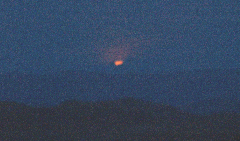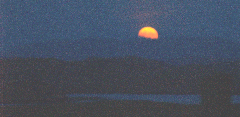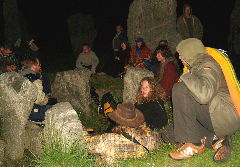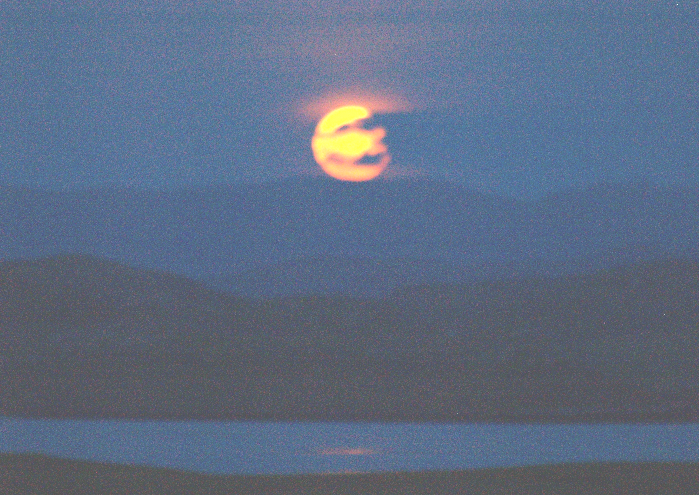
Callanish (Calanais)
Isle of Lewis, Scotland
- pages by
Gerald Ponting
Isle of Lewis, Scotland
- pages by
Gerald Ponting
At eleven minutes after midnight, a glimmer of orange light appeared in the sky at the point where moonrise was anticipated. A number of joyous whoops arose from the waiting crowd standing among the Stones of Callanish. The beat of drums, previously desultory, began to rise to a climax, almost as though the rhythm would encourage the moon to rise. But even now there was an uncertainty – was there thin cloud on the horizon, above the prone figure of the Sleeping Beauty, which would prevent the moon’s disc appearing?
A short while later, the question was answered by the appearance of a thin crescent, the upper limb of the full moon, just above the ‘abdomen’ of the sleeping figure. The excitement among the waiting ‘stones enthusiasts’ was palpable, while several television cameramen rushed back to their equipment to begin filming.
The moon, as it slowly rose, slid along the body of the figure. At 12.20 a.m. (below), the disc of the moon was free of the horizon, its lower limb just touching the ‘breasts’ of the figure. Two thin wisps of cloud across the moon’s face only added to the atmosphere.
My Callanish Moonrise ‘blog’ -
11th-12th June 2006
Page 1 of 3 pages
11th-12th June 2006
Page 1 of 3 pages




The full moon was, tonight, traversing one of its most southerly paths. At the high latitude of Callanish, on the Isle of Lewis in Scotland’s Outer Hebrides, this meant that the moon never rose high into the sky. Instead it skimmed just above the horizon for less than three hours before setting again. I’d waited 26 years to see this happen; and now my hope, above all, was that the sky would remain free of clouds and that I would be able to watch moonset within the stone circle.
However, the beautiful moonrise and the varied events of the previous 24 hours had already justified my long journey from southern England. I’d been at the Stones around midnight the previous day, when the sky was completely overcast, with no chance of seeing the moon. There were only small numbers of people at the site that night, most of them huddled inside the small burial chamber which lies within the great circle of megaliths. A small fire burnt in a bowl (preventing damage to the site) while drums and didgeridoos played. I left when drizzle started, expecting a long day to follow – a day which turned out completely unexpectedly.
My intention was to spend the day driving around the island alone (John, my travelling companion, wishing to spend the day fishing) and to revisit some of the spots which I knew well in the years that I had lived on the island. I went first to the delightful white sand beach of Dalmore and took scenic photographs (right) with my Olympus digital camera, a fairly recent replacement for the large 35mm Minolta kit that I’d used for decades. Dalmore had figured prominently in my life in the early 1980s, as I had been involved with extensive excavations at the upper limit of the beach, which had ultimately revealed a Bronze Age habitation site. Most of the work on this site had been done by my then wife Margaret. Although I’d left Lewis in 1984, she was still living on the island, and was now married to Ron Curtis.
...... go to next page

Web-site created by Gerald Ponting using Serif WebPlus X2
New page June 2006, tidied March 2009
All material copyright - see copyright notice
BACK TO TOP
Moonrise over the Sleeping Beauty: 12.11, 12.14 and 12.20 a.m. 12 June 2006
‘Party’ in the Callanish central cairn, around midnight 10th June
Dalmore beach
PLEASE NOTE : this blog dates from June 2006 and I’ve chosen to leave it as written.





